Bihar Board Class 10 Science Question Paper 2024 (Set G) with Answer Key pdf is available for download here. The Science paper was conducted on February 20, 2024 in the evening shift from 2 PM to 5:15 PM. The question paper was divided into two sections - Section A for objective questions and Section B for subjective questions.
Bihar Board Class 10 Science Question Paper 2024 (Set G) with Answer Key (Shift 2)
| Bihar Board Class 10 2024 Science Question Paper with Answer Key | Check Solution |
Bihar Board Class 10 Science Question Paper 2024 with Solutions
The magnification produced by a concave mirror of focal length 10 cm is positive, if the value of object distance is:
View Solution
The magnification of a mirror is given by:
\[ m = \frac{-v}{u} \]
For concave mirrors, magnification is positive when the image is virtual and erect. This happens when the object is placed between the focus and the pole of the mirror, i.e., when \( u < 10 \) cm.
Thus, the correct answer is \( \mathbf{(C) less than 10 cm} \).
Quick Tip: For concave mirrors, virtual and erect images are formed when the object is placed within the focal length.
On moving from focus towards the pole, the magnification in a concave mirror:
View Solution
The magnification of a concave mirror is given by:
\[ m = \frac{-v}{u} \]
As the object moves from the focus towards the pole, the image moves from infinity to the mirror itself, becoming virtual and highly magnified. Hence, the magnification increases.
Thus, the correct answer is \( \mathbf{(A) increases} \).
Quick Tip: Magnification in a concave mirror increases as the object approaches the mirror.
Which energy does a hydro-electric power plant convert into electric energy?
View Solution
In a hydroelectric power plant, water stored in a reservoir possesses potential energy due to its height. This potential energy is converted into kinetic energy as water flows down, which then turns turbines to generate electrical energy.
Thus, the correct answer is \( \mathbf{(C) Potential energy} \).
Quick Tip: Hydroelectric plants convert gravitational potential energy of water into electrical energy.
A rectangular coil of copper wire is rotated in a magnetic field. The direction of the induced current in the coil changes after:
View Solution
According to Faraday’s Law, a rotating coil in a magnetic field experiences a change in magnetic flux, inducing an alternating current. The direction of the current reverses every half rotation due to the reversal of the relative motion of the coil with respect to the field.
Thus, the correct answer is \( \mathbf{(B) every half rotation} \). Quick Tip: In AC generators, the current reverses direction every half rotation due to change in magnetic flux.
The image of an ant in a concave mirror is erect and goes on increasing as the ant moves along the principal axis. The direction of motion of the ant is:
View Solution
In a concave mirror, an erect and magnified image is formed only when the object is placed between the pole and the focus. As the ant moves from the pole towards the focus, its image increases in size.
Thus, the correct answer is \( \mathbf{(C) from pole to focus} \). Quick Tip: In concave mirrors, virtual and erect images are formed when the object is between the pole and the focus.
The radius of curvature of the lens of an eye is controlled by:
View Solution
The ciliary muscles are responsible for changing the curvature of the eye lens to adjust focus for near or distant objects. This process is called accommodation.
Thus, the correct answer is \( \mathbf{(D) ciliary muscles} \).
Quick Tip: Ciliary muscles help in adjusting the focal length of the eye lens for clear vision.
Why is the colour of some clouds white?
View Solution
Step 1: Clouds appear white because the water droplets within them scatter all wavelengths of sunlight equally. This is called Mie scattering.
Thus, the correct answer is \( \mathbf{(B) Due to scattering} \). Quick Tip: Scattering of sunlight by water droplets in clouds results in a white appearance.
The SI unit of resistance is:
View Solution
The SI unit of electrical resistance is the ohm (\(\Omega\)). It is defined by Ohm’s law as: \[ R = \frac{V}{I} \]
where \(V\) is voltage and \(I\) is current.
Thus, the correct answer is \( \mathbf{(C) ohm} \).
Quick Tip: Ohm’s law: \( R = V/I \) defines resistance in terms of voltage and current.
Depletion of ozone layer is due to:
View Solution
Chlorofluorocarbons (CFCs) release chlorine atoms in the stratosphere, which break down ozone molecules, leading to depletion of the ozone layer.
Thus, the correct answer is \( \mathbf{(B) CFC} \).
Quick Tip: CFCs cause ozone depletion by releasing chlorine, which destroys ozone molecules.
In which of the following organisms does asexual reproduction occur through budding?
View Solution
Budding is a type of asexual reproduction in which a new organism develops from an outgrowth or bud. Yeast reproduces by budding.
Thus, the correct answer is \( \mathbf{(D) \textit{Yeast} \).
Quick Tip: Budding is a form of asexual reproduction where a new organism grows from the parent.
An example of plant hormone is:
View Solution
Indole-3-acetic acid (IAA) is a naturally occurring plant hormone that belongs to the auxin group. It regulates plant growth and development.
Thus, the correct answer is \( \mathbf{(A) IAA} \).
Quick Tip: IAA (Indole-3-acetic acid) is an auxin that promotes plant growth.
Vegetative propagation in potato takes place by:
View Solution
In potatoes, vegetative propagation occurs through underground stems called tubers. Buds on the tuber sprout and grow into new plants.
Thus, the correct answer is \( \mathbf{(D) stem} \).
Quick Tip: Potatoes reproduce vegetatively through underground stem tubers.
Hydrilla is found:
View Solution
Hydrilla is an aquatic plant found in freshwater bodies like lakes, ponds, and rivers.
Thus, the correct answer is \( \mathbf{(A) in water \).
Quick Tip: Hydrilla is an aquatic plant commonly found in freshwater environments.
Systolic blood pressure of a healthy person is:
View Solution
Systolic blood pressure is the pressure exerted by blood on artery walls when the heart contracts. The normal systolic blood pressure for a healthy person is approximately 120 mm Hg.
- If the systolic pressure is above 140 mm Hg, it indicates hypertension (high blood pressure).
- If it is below 90 mm Hg, it may indicate hypotension (low blood pressure).
Thus, the correct answer is \( \mathbf{(B) 120 mm Hg} \).
Quick Tip: A normal systolic blood pressure is around 120 mm Hg, which helps ensure proper circulation of blood in the body.
An example of a bisexual organism is:
View Solution
Step 1: A bisexual organism possesses both male and female reproductive organs. Hydra is an example of a hermaphrodite that can produce both eggs and sperm.
Thus, the correct answer is \( \mathbf{(A) \textit{Hydra} \). Quick Tip: Bisexual organisms have both male and female reproductive organs.
In fish, respiration takes place through:
View Solution
Fish respire through gills, which extract oxygen from water and expel carbon dioxide. The gill filaments provide a large surface area for gas exchange.
Thus, the correct answer is \( \mathbf{(B) gills} \).
Quick Tip: Fish use gills to extract dissolved oxygen from water.
Kilowatt-hour (kWh) is the unit of:
View Solution
The kilowatt-hour (kWh) is a unit of energy, commonly used to measure electrical energy consumption.
\[ 1 kWh = 1000 W \times 3600 s = 3.6 \times 10^6 J. \]
Thus, the correct answer is \( \mathbf{(A) energy} \).
Quick Tip: A kilowatt-hour (kWh) represents the energy consumed when 1 kW of power is used for 1 hour.
The amount of light entering the human eye is controlled by:
View Solution
The iris is a circular muscle that controls the size of the pupil, regulating the amount of light entering the eye
Thus, the correct answer is \( \mathbf{(D) iris} \).
Quick Tip: The iris adjusts the pupil size to regulate light entry into the eye.
Which is the conventional source of energy?
View Solution
Conventional energy sources include fossil fuels and biomass, which have been used for centuries for energy generation.Thus, the correct answer is \( \mathbf{(C) Biomass} \).
Quick Tip: Biomass, coal, and petroleum are conventional energy sources.
The maximum number of electrons in a shell is:
View Solution
The maximum number of electrons that a shell can hold is given by the formula:
\[ Maximum electrons = 2n^2 \]
where \(n\) is the principal quantum number.
Thus, the correct answer is \( \mathbf{(C) 2n^2} \).
Quick Tip: The electron capacity of a shell follows the \(2n^2\) rule.
Which hydrocarbon is the simplest compound?
View Solution
Step 1: The simplest hydrocarbon is methane (\(CH_4\)), which consists of one carbon atom bonded to four hydrogen atoms. It is the smallest and lightest alkane. Thus, the correct answer is \( \mathbf{(A) Methane} \).
Quick Tip: Methane (\(CH_4\)) is the simplest hydrocarbon with a single carbon atom.
Which of the following metals has the lowest melting point?
View Solution
Sodium (Na) is an alkali metal with a very low melting point of around \(97.8^\circ C\), making it one of the softest metals that melts easily under heat.Thus, the correct answer is \( \mathbf{(A) Na} \).
Quick Tip: Alkali metals like sodium have low melting points compared to transition metals.
The atomic number of gold is:
View Solution
The atomic number of an element represents the number of protons in its nucleus. Gold (Au) has an atomic number of 79. Thus, the correct answer is \( \mathbf{(C) 79} \).
Quick Tip: Gold (Au) has an atomic number of 79 and belongs to group 11 in the periodic table.
Which of the following is a salt?
View Solution
A salt is a compound formed from the neutralization reaction between an acid and a base. Potassium sulfate (\(K_2SO_4\)) is a salt as it is formed from sulfuric acid and potassium hydroxide.
Thus, the correct answer is \( \mathbf{(D) K_2SO_4} \).
Quick Tip: Salts are neutral compounds formed from acid-base reactions.
The expulsion of water through stomata in the form of vapour from the aerial part of the plant is known as:
View Solution
Transpiration is the process by which water evaporates from the aerial parts of plants, primarily through stomata. It helps in cooling the plant and maintaining water balance.Thus, the correct answer is \( \mathbf{(B) transpiration} \).
Quick Tip: Transpiration plays a vital role in the water cycle and nutrient transport in plants.
The tiger is a consumer of:
View Solution
In an ecological food chain, producers occupy the first trophic level, herbivores the second, and carnivores such as tigers the third trophic level.Thus, the correct answer is \( \mathbf{(C) third trophic level} \).
Quick Tip: Tigers are tertiary consumers in a food chain, preying on herbivores.
The place of origin of humans is:
View Solution
Scientific evidence suggests that modern humans (Homo sapiens) originated in Africa around 200,000 years ago before migrating to other continents.Thus, the correct answer is \( \mathbf{(C) Africa} \).
Quick Tip: The "Out of Africa" theory suggests that early humans migrated from Africa to other parts of the world.
Peristalsis movement is found in:
View Solution
Peristalsis is a series of wave-like muscle contractions that move food through the digestive tract. It mainly occurs in the oesophagus, stomach, and intestines.
Thus, the correct answer is \( \mathbf{(B) Oesophagus} \).
Quick Tip: Peristalsis helps in the movement of food from the mouth to the stomach.
Open circulatory system is found in:
View Solution
In an open circulatory system, blood is not confined to vessels but flows freely in body cavities. Insects like butterflies have this type of circulatory systemThus, the correct answer is \( \mathbf{(B) butterfly} \).
Quick Tip: Open circulatory systems are found in arthropods and some mollusks.
The carrier of oxygen in blood is:
View Solution
Haemoglobin is an iron-containing protein in red blood cells that binds to oxygen and transports it throughout the body.Thus, the correct answer is \( \mathbf{(C) haemoglobin} \).
Quick Tip: Haemoglobin helps transport oxygen from the lungs to tissues.
The number of pairs of autosomes in humans is:
View Solution
Humans have 23 pairs of chromosomes, out of which 22 pairs are autosomes (non-sex chromosomes), and the 23rd pair consists of sex chromosomes (XX in females, XY in males). Thus, the correct answer is \( \mathbf{(D) 22} \).
Quick Tip: Humans have 46 chromosomes in total, out of which 44 are autosomes and 2 are sex chromosomes.
The most effective color of visible light spectrum for photosynthesis is:
View Solution
The absorption spectrum of chlorophyll shows that red and blue light are the most effective for photosynthesis. However, red light is absorbed more efficiently than blue. Green light is the least effective because it is mostly reflected, giving plants their green color.Thus, the correct answer is \( \mathbf{(A) red} \).
Quick Tip: Chlorophyll absorbs red and blue light best, with red being the most effective for photosynthesis.
The valency of all elements in a group of the periodic table is:
View Solution
Elements in the same group of the periodic table have the same valency because they have the same number of valence electrons. Thus, the correct answer is \( \mathbf{(A) same} \).
Quick Tip: Elements in a group exhibit the same valency but different physical and chemical properties.
Which of the following is used as wine?
View Solution
Ethanol (\(C_2H_5OH\)) is the type of alcohol found in alcoholic beverages such as wine. It is produced by fermentation of sugars. Thus, the correct answer is \( \mathbf{(A) Ethanol} \).
Quick Tip: Ethanol is a consumable alcohol, while methanol is toxic to humans.
What is the number of elements in the third group of the periodic table?
View Solution
The third group of the periodic table consists of elements including scandium, yttrium, and the lanthanides, totaling 10 elements. Thus, the correct answer is \( \mathbf{(C) 10} \).
Quick Tip: Group 3 of the periodic table includes transition metals and lanthanides.
Which is used in Solar cells?
View Solution
Silicon is the most commonly used material in solar cells due to its excellent semiconducting properties and abundance. Thus, the correct answer is \( \mathbf{(C) Silicon} \).
Quick Tip: Silicon-based solar cells efficiently convert sunlight into electricity.
The electronic configuration of an element is 2,8,7. What is the atomic number of the element?
View Solution
The atomic number of an element is determined by the total number of electrons. Given the configuration \(2,8,7\), summing these gives: \[ 2 + 8 + 7 = 17 \]
This corresponds to chlorine (\(Cl\)).
Thus, the correct answer is \( \mathbf{(C) 17} \).
Quick Tip: The atomic number of an element is equal to the total number of electrons in a neutral atom.
Duralumin is an alloy of which metal?
View Solution
Duralumin is an alloy mainly composed of aluminum (Al), along with copper, manganese, and magnesium, making it lightweight and strong. Thus, the correct answer is \( \mathbf{(C) Aluminum} \).
Quick Tip: Duralumin is widely used in aircraft construction due to its strength and low weight.
The molecular formula of sodium phosphate is:
View Solution
Sodium phosphate is a chemical compound with the molecular formula \( Na_3PO_4 \), commonly used in detergents and food additives. Thus, the correct answer is \( \mathbf{(B) Na_3PO_4} \).
Quick Tip: Sodium phosphate is used as a food additive and in water treatment.
The structural and functional unit of the kidney is called:
View Solution
The nephron is the basic structural and functional unit of the kidney. It is responsible for the filtration of blood, reabsorption of essential substances, and excretion of waste in the form of urine. Thus, the correct answer is \( \mathbf{(D) Nephron} \).
\ Quick Tip: Each kidney contains about a million nephrons that help in urine formation and waste removal.
What should be the minimum speed of wind in a wind electric generator?
View Solution
Wind turbines require a minimum wind speed of around 12-15 km/h to start generating electricity efficiently. This speed ensures that the blades rotate and produce sufficient energy. Thus, the correct answer is \( \mathbf{(C) 15 km/h} \).
Quick Tip: Wind turbines typically require wind speeds between 12-15 km/h to start generating electricity efficiently.
A split ring is used in:
View Solution
A split ring is used in a D.C. motor to reverse the direction of current in the armature coil after every half rotation. This ensures continuous rotation in one direction.
Thus, the correct answer is \( \mathbf{(B) D.C. motor} \).
Quick Tip: Split rings act as commutators in a D.C. motor to maintain unidirectional motion.
Metallic conduction is based on motion of which particle in material?
View Solution
Metallic conduction occurs due to the movement of free electrons within a metal lattice. These electrons move under the influence of an electric field, allowing conduction of electricity. Thus, the correct answer is \( \mathbf{(A) Electron} \).
Quick Tip: Free electrons in metals are responsible for electrical conductivity.
The upper part of a box-type solar cooker has a glass cover. The reason for this is:
View Solution
A glass cover in a solar cooker allows sunlight to enter while trapping heat inside, and it also enables users to check the cooking process without opening the lid. Thus, the correct answer is \( \mathbf{(A) To see whether the food kept inside is being cooked or not} \).
Quick Tip: Solar cookers use the greenhouse effect to trap heat and cook food efficiently.
A resistor of power \( P_1 \) at voltage \( V_1 \) is connected in series with another resistor of power \( P_2 \) at voltage \( V_2 \). The equivalent resistance will be:
View Solution
Using the power formula \( P = \frac{V^2}{R} \), the equivalent resistance in series is derived as: \[ R_{eq} = \frac{V_1^2}{P_1} + \frac{V_2^2}{P_2} \]
Thus, the correct answer is \( \mathbf{(A) \frac{V_1^2}{P_1} + \frac{V_2^2}{P_2}} \).
Quick Tip: Power and resistance are related by the formula \( P = \frac{V^2}{R} \).
The frequency of alternating current in household electric circuit is:
View Solution
In most countries, the standard frequency of AC mains supply is 50 Hz. In some countries like the USA, it is 60 Hz. Thus, the correct answer is \( \mathbf{(A) 50 Hz} \).
Quick Tip: The frequency of household AC supply is 50 Hz in most countries.
Which of the following has the lowest refractive index?
View Solution
The refractive index of kerosene is lower compared to turpentine, benzene, and water, meaning light travels faster in kerosene than in the other substances. Thus, the correct answer is \( \mathbf{(D) Kerosene} \).
Quick Tip: Refractive index determines how much light slows down when passing through a medium.
A simple prism is bounded by how many surfaces?
View Solution
A simple triangular prism consists of three rectangular lateral surfaces and two triangular bases. In total, the prism is bounded by five surfaces: three rectangular faces and two triangular bases. Thus, the correct answer is \( \mathbf{(C) 5} \).
Quick Tip: A prism typically has three rectangular faces and two triangular bases, summing up to five surfaces.
Kidney helps in
View Solution
The kidney plays a vital role in the excretion of waste products from the body. It filters the blood to remove toxins and excess substances, which are then excreted as urine. Therefore, the correct answer is \( \mathbf{(C) excretion} \).
Quick Tip: The kidneys are primarily responsible for filtering and excreting waste from the body.
Photosynthesis takes place during:
View Solution
Photosynthesis is the process by which plants convert light energy into chemical energy. Since it requires sunlight, it occurs only during the daytime. Thus, the correct answer is \( \mathbf{(B) Day only} \).
Quick Tip: Photosynthesis occurs in the presence of sunlight, primarily during the day.
Synaptic knobs are found in:
View Solution
Synaptic knobs are structures at the ends of neurons that release neurotransmitters to transmit nerve impulses between neurons or to muscles. Thus, the correct answer is \( \mathbf{(D) Neuron} \).
Quick Tip: Synaptic knobs help in the transmission of nerve signals through neurotransmitters.
Which of the following has the fastest heartbeat?
View Solution
Smaller animals generally have a higher metabolic rate and a faster heartbeat. Rats have a heart rate of around 300-400 beats per minute. Thus, the correct answer is \( \mathbf{(C) Rat} \).
Quick Tip: Smaller animals like rats have higher heart rates compared to larger mammals.
Which of the following is cellular fuel?
View Solution
Glucose is the primary energy source for cells. It undergoes cellular respiration to produce ATP, which powers cellular functions. Thus, the correct answer is \( \mathbf{(B) Glucose} \).
Quick Tip: Glucose is broken down through glycolysis to generate ATP for energy.
How many phosphates are there in ATP?
View Solution
Adenosine triphosphate (ATP) consists of three phosphate groups, which provide energy when broken down into ADP and inorganic phosphate. Thus, the correct answer is \( \mathbf{(C) 3} \).
Quick Tip: ATP (Adenosine Triphosphate) contains three phosphate groups and serves as the energy currency of the cell.
Which of the following is not an excretory organ of humans?
View Solution
The pancreas is involved in digestion and hormone production but does not function as an excretory organ.
Thus, the correct answer is \( \mathbf{(C) Pancreas} \).
Quick Tip: Lungs, kidneys, and skin play a role in excretion, but the pancreas is part of the digestive and endocrine systems.
The smallest endocrine gland is:
View Solution
The pineal gland, located in the brain, is the smallest endocrine gland and is responsible for producing melatonin, which regulates sleep. Thus, the correct answer is \( \mathbf{(C) Pineal} \).
Quick Tip: The pineal gland is a pea-sized structure that plays a key role in sleep regulation.
All acids dissolve in water to give:
View Solution
Acids are substances that release hydrogen ions (\( H^+ \)) when dissolved in water. The presence of \( H^+ \) ions determines the acidic nature of a solution. Thus, the correct answer is \( \mathbf{(A) H^+ ion} \). \
Quick Tip: Acids ionize in water to produce \( H^+ \) ions, which define their acidic properties.
Which of the following compounds is a weak acid?
View Solution
A weak acid only partially ionizes in water. Acetic acid (\( CH_3COOH \)) is a weak acid because it does not completely dissociate in solution, unlike strong acids such as \( HCl, H_2SO_4, \) and \( HNO_3 \).
Thus, the correct answer is \( \mathbf{(B) CH_3COOH} \).
Quick Tip: Strong acids completely ionize in water, whereas weak acids only partially ionize.
What is the colour of silver iodide?
View Solution
Silver iodide (\( AgI \)) is a yellow-colored compound, which is used in weather modification and cloud seeding.
Thus, the correct answer is \( \mathbf{(C) Yellow} \).
Quick Tip: Silver chloride is white, silver bromide is pale yellow, and silver iodide is deep yellow.
The hardest natural substance is:
View Solution
Diamond is the hardest natural substance due to its strong covalent bonding in a three-dimensional tetrahedral structure.Thus, the correct answer is \( \mathbf{(C) Diamond} \).
Quick Tip: Diamond is the hardest known material with a Mohs hardness of 10.
How many crystalline allotropes of carbon are there?
View Solution
Carbon has three main crystalline allotropes: diamond, graphite, and fullerenes.
Thus, the correct answer is \( \mathbf{(C) 3} \).
Quick Tip: Diamond, graphite, and fullerenes are crystalline allotropes of carbon.
Zinc blende is an ore of which metal?
View Solution
Step 1:
Zinc blende (\( ZnS \)) is a major ore of zinc, from which zinc is extracted by roasting and reduction.
Thus, the correct answer is \( \mathbf{(B) Zn} \).
Quick Tip: Zinc is extracted from zinc blende using the roasting and reduction process.
How many bonds are there between two atoms in a nitrogen molecule?
View Solution
A nitrogen molecule (\( N_2 \)) has a triple bond (\( N \equiv N \)) between its two nitrogen atoms, making it very stable. Thus, the correct answer is \( \mathbf{(C) 3} \).
Quick Tip: The nitrogen molecule has a strong triple bond, making it chemically inert.
The general formula of alkyne is:
View Solution
Alkynes are hydrocarbons with at least one triple bond, and their general formula is \( C_nH_{2n-2} \).
Thus, the correct answer is \( \mathbf{(C) C_nH_{2n-2}} \).
Quick Tip: Alkynes follow the general formula \( C_nH_{2n-2} \) and have at least one triple bond.
The far point for normal vision is:
View Solution
For a normal human eye, the far point is at infinity, meaning distant objects can be seen clearly.
Thus, the correct answer is \( \mathbf{(D) Infinity} \).
Quick Tip: The far point of a normal eye is infinity, while the near point is around 25 cm.
What will be the nature of the image of an object, if the magnification of the image is negative?
View Solution
The magnification (\( m \)) of an image is given by:
\[ m = \frac{height of image}{height of object} \]
If the magnification is negative, it means the image is inverted. A real image is always inverted in the case of a concave mirror or convex lens when the object is beyond the focal point.
Thus, the correct answer is \( \mathbf{(D) Real and inverted} \).
Quick Tip: A negative magnification indicates an inverted and real image, while a positive magnification means an upright and virtual image.
How many laws are there for the reflection of light?
View Solution
The two laws of reflection state that:
1. The angle of incidence is equal to the angle of reflection.
2. The incident ray, the reflected ray, and the normal to the surface all lie in the same plane.
Thus, the correct answer is \( \mathbf{(B) 2} \).
Quick Tip: Reflection follows two fundamental laws which apply to both plane and curved mirrors.
A ray of light is incident perpendicular to a plane mirror. The angle of reflection will be:
View Solution
When a ray of light is incident normally (perpendicularly) on a mirror, it retraces its path. This means the angle of reflection is 0°. Thus, the correct answer is \( \mathbf{(D) 0°} \).
Quick Tip: If the angle of incidence is 0°, the angle of reflection is also 0°.
Which colour of light scatters more in the atmosphere?
View Solution
According to Rayleigh scattering, shorter wavelengths of light scatter more. Since blue has a shorter wavelength than red, it scatters the most in Earth's atmosphere, making the sky appear blue.Thus, the correct answer is \( \mathbf{(D) Blue} \).
Quick Tip: Rayleigh scattering is responsible for the blue color of the sky.
Converging lens in air is:
View Solution
A convex lens is a converging lens because it brings parallel rays of light to a focus at a single point.
Thus, the correct answer is \( \mathbf{(C) Convex lens of glass} \).
Quick Tip: A convex lens converges light rays, while a concave lens diverges them.
If the lower half of a concave mirror gets broken, then the image:
View Solution
Even if part of the mirror is broken, the image will still be formed, but its brightness (intensity) will be reduced due to less reflecting surface. Thus, the correct answer is \( \mathbf{(C) Will be less intense} \).
Quick Tip: A reduced mirror size decreases image brightness but does not distort the image.
When a ray of light travels from air (a rarer medium) to glass (a denser medium), it bends:
View Solution
When light enters a denser medium, its speed decreases and it bends towards the normal. This is due to the change in refractive index. Thus, the correct answer is \( \mathbf{(B) Towards the normal} \).
Quick Tip: Light bends towards the normal when moving from a rarer to a denser medium.
Which one of the following is the natural source of oxalic acid?
View Solution
Tamarind contains oxalic acid, which gives it a sour taste. It is a natural source of oxalic acid.
Thus, the correct answer is \( \mathbf{(B) Tamarind} \).
Quick Tip: Tamarind and rhubarb are rich sources of oxalic acid.
Propane, with the molecular formula \( C_3H_8 \), has:
View Solution
Propane (\( C_3H_8 \)) consists of 3 carbon atoms bonded with 8 hydrogen atoms, making a total of 9 covalent bonds. Thus, the correct answer is \( \mathbf{(C) 9 covalent bonds} \).
Quick Tip: Alkanes form single covalent bonds, and propane has 9 covalent bonds.
Ozone layer protects earth from which harmful radiation?
View Solution
The ozone layer in Earth's stratosphere absorbs most of the Sun’s ultraviolet (UV) radiation, preventing harmful UV rays from reaching the surface. Thus, the correct answer is \( \mathbf{(C) Ultraviolet} \).
Quick Tip: The ozone layer is crucial for blocking harmful UV radiation that can cause skin cancer.
Which non-metal is found in liquid state at room temperature?
View Solution
Bromine (\( Br_2 \)) is the only non-metal that exists as a liquid at room temperature. Mercury is also a liquid, but it is a metal. Thus, the correct answer is \( \mathbf{(B) Bromine} \).
Quick Tip: Bromine is a reddish-brown liquid at room temperature.
Which one of the following is a metalloid?
View Solution
Metalloids have properties of both metals and non-metals. Arsenic (\( As \)) is a metalloid, while iron (\( Fe \)), nickel (\( Ni \)), and copper (\( Cu \)) are metals.Thus, the correct answer is \( \mathbf{(D) As} \).
Quick Tip: Metalloids include elements like silicon, boron, and arsenic.
CaCO\(_3\)(s) → CaO(s) + CO\(_2\)(g) is what type of reaction?
View Solution
A decomposition reaction occurs when a single compound breaks down into two or more simpler substances. Calcium carbonate decomposes into calcium oxide and carbon dioxide when heated. Thus, the correct answer is \( \mathbf{(A) Decomposition} \).
Quick Tip: Decomposition reactions often require heat, light, or electricity.
Which of the following equations is balanced?
View Solution
The equation Fe + Cl\(_2\) \(\rightarrow\) FeCl\(_3\) is balanced because it has equal numbers of iron and chlorine atoms on both sides of the equation. On the other hand, the other equations are not balanced, as they do not have the same number of atoms for each element on both sides. Thus, the correct answer is \( \mathbf{(C) Fe + Cl_2 \rightarrow FeCl_3} \).
Quick Tip: To check if an equation is balanced, count the number of atoms of each element on both sides of the equation.
Which of the following causes acid rain in industrial areas?
View Solution
Sulphur dioxide (\( SO_2 \)) and nitrogen oxides (\( NO_x \)) react with water vapor in the atmosphere to form acid rain, which harms ecosystems.
Thus, the correct answer is \( \mathbf{(B) Sulphur dioxide} \).
Quick Tip: Industrial pollution, mainly from burning fossil fuels, leads to acid rain.
Draw a labelled diagram of an electric bulb.
View Solution
A labelled diagram of an electric bulb consists of the following parts:
- Filament (usually tungsten)
- Glass envelope
- Inert gas filling
- Metal base and contacts
- Support wires
Quick Tip: The filament of an electric bulb is made of tungsten due to its high melting point.
What is persistence of vision?
View Solution
Persistence of vision refers to the phenomenon where an image stays on the retina for approximately \( 1/16^{th} \) of a second even after the object is removed. This principle is used in motion pictures.
Quick Tip: Movies and animations work on the principle of persistence of vision.
Draw a ray diagram to show refraction of light at both refractive surfaces of a prism placed in air.
View Solution
The following ray diagram shows the refraction of light at both refractive surfaces of a prism:
Quick Tip: Refraction occurs due to a change in speed when light travels between different media.
What do you mean by power of a lens? Write its SI unit.
View Solution
The power of a lens (\( P \)) is defined as the reciprocal of its focal length (\( f \)) in meters:
\[ P = \frac{1}{f} \]
The SI unit of power of a lens is dioptre (\( D \)), where \( 1D = 1m^{-1} \).
Quick Tip: A convex lens has positive power, while a concave lens has negative power.
What is a simple microscope? Draw its ray diagram.
View Solution
A simple microscope is an optical device that consists of a single convex lens used to magnify small objects. It is commonly used in biology and scientific observations. Working Principle: The object is placed within the focal length of the convex lens, producing an enlarged, virtual, and erect image.
Quick Tip: The magnification of a simple microscope depends on the focal length of the convex lens.
What is the law of refraction of light?
View Solution
The laws of refraction of light state that:
1. The incident ray, the refracted ray, and the normal to the interface of two media lie in the same plane.
2. The ratio of the sine of the angle of incidence (\( i \)) to the sine of the angle of refraction (\( r \)) is a constant, known as Snell’s law:
\[ \frac{\sin i}{\sin r} = n \]
where \( n \) is the refractive index of the second medium with respect to the first. Quick Tip: Snell's law governs the bending of light when it passes from one medium to another.
What do you understand by 'short-circuit'?
View Solution
A short circuit occurs when a low-resistance path is formed in an electrical circuit, causing excessive current to flow. This can be due to:
- Direct contact between live and neutral wires
- Faulty insulation or damaged wires
- Overloaded circuits
Effects of Short Circuit:
- Sudden increase in current
- Potential fire hazards
- Damage to electrical appliances
Quick Tip: Circuit breakers and fuses are used to prevent damage from short circuits.
How is the resistance of a wire affected by its area of cross-section?
View Solution
The resistance (\( R \)) of a wire is given by:
\[ R = \rho \frac{L}{A} \]
where:
- \( \rho \) is the resistivity of the material
- \( L \) is the length of the wire
- \( A \) is the cross-sectional area of the wire
Effect:
- If the area of cross-section (\( A \)) increases, resistance decreases.
- If the area of cross-section (\( A \)) decreases, resistance increases.
Quick Tip: Thicker wires have lower resistance, allowing more current to flow.
Define focus of a concave spherical mirror. Prove that in a concave mirror \( R = 2f \).
View Solution
Definition of Focus:
The focus (\( F \)) of a concave mirror is the point on its principal axis where parallel rays of light converge after reflection from the mirror’s surface.
Proof that \( R = 2f \):
Consider a concave spherical mirror with:
- \( R \) as the radius of curvature
- \( C \) as the center of curvature
- \( P \) as the pole of the mirror
- \( F \) as the focal point
- \( f \) as the focal length
### Step 1: Relationship Between Radius of Curvature and Focal Length
From the mirror formula:
\[ \frac{1}{f} = \frac{1}{u} + \frac{1}{v} \]
For a parallel beam of light incident on a concave mirror:
- The incident rays are parallel, so \( u = \infty \).
- The reflected rays converge at the focus, so \( v = f \).
Thus, substituting in the mirror formula:
\[ \frac{1}{f} = \frac{1}{\infty} + \frac{1}{v} \] \[ \frac{1}{f} = \frac{1}{v} \] \[ v = f \]
Since by definition, the center of curvature (\( C \)) lies at a distance \( R \) from the pole (\( P \)), we have the geometric relationship:
\[ R = 2f \]
### Conclusion:
Thus, the radius of curvature (\( R \)) of a concave mirror is twice its focal length (\( f \)), proving that:
\[ R = 2f \]
Quick Tip: The focal length of a spherical mirror is half of its radius of curvature.
Explain conductor, insulator, and semiconductor with examples.
View Solution
1. Conductors:
Conductors are materials that allow electric current to pass through them easily due to the presence of free electrons. They have low electrical resistance.
Examples:
- Metals such as Copper (Cu), Silver (Ag), and Aluminum (Al)
- Graphite (a form of carbon)
- Saltwater (electrolytes)
Properties of Conductors:
- High electrical and thermal conductivity.
- Allow the free flow of electric charges.
- Used in electrical wiring and transmission lines.
2. Insulators:
Insulators are materials that do not allow the flow of electric current because they lack free electrons. They have high electrical resistance.
Examples:
- Rubber, Plastic, and Glass
- Dry Wood
- Air and Pure Water
Properties of Insulators:
- High resistance to electric current.
- Used for insulation in electrical wiring.
- Prevent electrical shock and leakage.
3. Semiconductors:
Semiconductors are materials that have electrical conductivity between conductors and insulators. Their conductivity can be altered by adding impurities (doping) or changing environmental conditions like temperature and light.
Examples:
- Silicon (Si)
- Germanium (Ge)
- Gallium Arsenide (GaAs)
Properties of Semiconductors:
- Their conductivity increases with temperature.
- Used in electronic devices such as transistors, diodes, and integrated circuits (ICs).
- The basis for modern computing and communication technology.
Quick Tip: Semiconductors form the foundation of electronic circuits. Silicon (Si) is the most widely used semiconductor in microchips and solar cells.
Write the balanced chemical equations for the following reactions:
(a) Zinc + Silver nitrate → Zinc nitrate + Silver
(b) Sodium + Water → Sodium hydroxide + Hydrogen.
View Solution
Balanced Chemical Equations:
\[ (a) Zn + 2AgNO_3 \rightarrow Zn(NO_3)_2 + 2Ag \] \[ (b) 2Na + 2H_2O \rightarrow 2NaOH + H_2 \] Quick Tip: Balancing chemical equations ensures that the law of conservation of mass is followed.
What are the essential steps for forest conservation?
View Solution
Steps for Forest Conservation:
1. Afforestation: Planting more trees to increase green cover.
2. Controlling Deforestation: Preventing excessive tree cutting and illegal logging.
3. Sustainable Use: Using forest resources responsibly to maintain ecological balance.
4. Wildlife Protection: Establishing protected areas to conserve biodiversity.
5. Reforestation: Restoring degraded forest lands by planting native trees.
Quick Tip: Conserving forests helps in maintaining biodiversity, preventing soil erosion, and combating climate change.
Why does carbon mainly form covalent compounds?
View Solution
Carbon mainly forms covalent compounds because:
1. It has four valence electrons and needs four more to complete its octet.
2. It cannot lose four electrons (high energy required) or gain four electrons (unstable).
3. It forms covalent bonds by sharing electrons with other elements.
Quick Tip: Carbon forms strong covalent bonds due to its small atomic size and high electronegativity.
What is the difference between displacement and double displacement reactions? Write equations for these reactions.
View Solution
Difference:
- Displacement Reaction: A more reactive element replaces a less reactive one in a compound.
- Double Displacement Reaction: Exchange of ions occurs between two compounds to form new products.
Examples: \[ Displacement: CuSO_4 + Zn \rightarrow ZnSO_4 + Cu \] \[ Double Displacement: NaCl + AgNO_3 \rightarrow AgCl + NaNO_3 \] Quick Tip: Double displacement reactions often result in the formation of a precipitate.
Name the sodium compound which is used for softening hard water.
View Solution
The sodium compound used for softening hard water is sodium carbonate (\( Na_2CO_3 \)), commonly known as washing soda.
Quick Tip: Sodium carbonate removes hardness by precipitating calcium and magnesium ions as insoluble carbonates.
What is Anodising?
View Solution
Anodising is the process of forming a thick oxide layer on metals like aluminum to increase corrosion resistance. It is done by electrolysis using sulfuric acid as an electrolyte.
Quick Tip: Anodised aluminum is widely used in cookware and decorative items.
Write two differences between minerals and ores.
View Solution
Difference between Minerals and Ores:
\begin{tabular{|p{5cm|p{5cm|
\hline
Minerals & Ores
\hline
Naturally occurring inorganic substances. & Ores are minerals that contain a high percentage of metal.
\hline
Not all minerals are ores. & All ores are minerals.
\hline
Example: Quartz (SiO\(_2\)) & Example: Bauxite (Al\(_2\)O\(_3\).2H\(_2\)O)
\hline
\end{tabular Quick Tip: Ores are extracted and refined to obtain pure metals.
The aqueous solution of sodium carbonate is alkaline. Why?
View Solution
Sodium carbonate (\( Na_2CO_3 \)) is a salt of a strong base (NaOH) and a weak acid (H\(_2\)CO\(_3\)). When dissolved in water, it undergoes hydrolysis:
\[ Na_2CO_3 + H_2O \rightarrow 2Na^+ + HCO_3^- + OH^- \]
Since hydroxide (\( OH^- \)) ions are produced, the solution becomes alkaline.
Quick Tip: Sodium carbonate is used in laundry detergents due to its alkalinity.
Write down the laboratory method of preparation of methane and its chemical reaction with chlorine.
View Solution
Laboratory Preparation of Methane:
Methane (\(CH_4\)) is prepared in the laboratory by heating sodium acetate with soda lime (a mixture of NaOH and CaO).
\[ CH_3COONa + NaOH \rightarrow CH_4 + Na_2CO_3 \]
Reaction with Chlorine:
Methane reacts with chlorine in the presence of sunlight, leading to a substitution reaction:
\[ CH_4 + Cl_2 \xrightarrow{hv} CH_3Cl + HCl \]
Further chlorination leads to the formation of dichloromethane, trichloromethane, and tetrachloromethane.
\[ CH_3Cl + Cl_2 \xrightarrow{hv} CH_2Cl_2 + HCl \] Quick Tip: Methane undergoes substitution reactions with halogens in the presence of UV light.
What is the effect of deforestation on wildlife?
View Solution
Deforestation has severe consequences on wildlife:
1. Habitat Destruction: Loss of natural habitat forces animals to migrate or face extinction.
2. Food Shortage: Deforestation leads to reduced availability of food resources for herbivores, affecting the food chain.
3. Loss of Biodiversity: Many species become endangered due to the destruction of their natural environment.
4. Climate Change: It disturbs the ecological balance, leading to unpredictable weather patterns.
Quick Tip: Forests act as carbon sinks, helping in controlling climate change.
Write the importance of reproduction in living beings.
View Solution
Reproduction is a fundamental process for the survival of species. The importance of reproduction includes:
1. Continuation of Species: Reproduction is essential to ensure the continuation of a species across generations. Without reproduction, life would cease to exist.
2. Genetic Variation: Sexual reproduction introduces genetic diversity, which is important for the survival and evolution of species. This genetic variation allows organisms to adapt to changing environments.
3. Growth of Population: Reproduction ensures the growth and maintenance of population size. It helps maintain ecological balance, supporting the sustainability of ecosystems.
\hrule Quick Tip: Reproduction is crucial not only for survival but also for adaptation and evolution of species.
Explore the difference between blood and lymph.
View Solution
\begin{tabular{|p{5cm|p{5cm|
\hline
Blood & Lymph
\hline
Contains red blood cells, white blood cells, and platelets. & Contains only white blood cells.
\hline
Transports oxygen and nutrients to tissues. & Helps in immunity and transport of fats.
\hline
Flows in arteries and veins. & Flows in lymphatic vessels.
\hline
Has a red color due to the presence of hemoglobin. & Has a pale yellow color, due to the absence of hemoglobin.
\hline
Plays a crucial role in immune response and clotting. & Plays a key role in the removal of waste and transporting fats.
\hline
\end{tabular Quick Tip: Blood transports oxygen and nutrients, while lymph primarily assists with immunity and waste removal.
What is external respiration?
View Solution
External respiration is the biological process in which oxygen is absorbed into the bloodstream from the environment, and carbon dioxide is expelled from the bloodstream to the environment. In humans and animals, it takes place in the lungs, while in fish, it occurs through gills. This process involves the diffusion of gases through the respiratory membrane, allowing the body to get the oxygen it needs for cellular processes and expelling the waste gas, carbon dioxide.
Quick Tip: External respiration is essential for the gas exchange that supports cellular respiration and overall metabolic processes.
Why do we sweat in summer?
View Solution
Sweating is a natural process of thermoregulation. In hot weather, when the body temperature rises, sweat glands release moisture (sweat) onto the surface of the skin. The evaporation of sweat from the skin helps to cool the body by removing excess heat. This is a vital mechanism that helps maintain a constant body temperature, ensuring proper enzymatic functions and overall homeostasis.
Quick Tip: Sweating helps regulate body temperature, preventing overheating and maintaining internal balance.
What is photosynthesis? Write the equation of its chemical reaction.
View Solution
Photosynthesis is the biochemical process by which green plants, algae, and some bacteria convert light energy into chemical energy, using sunlight, carbon dioxide, and water. The energy from sunlight is absorbed by chlorophyll, a pigment found in plant cells. This process produces glucose, which serves as a source of energy, and oxygen is released as a by-product. The general equation for photosynthesis is:
\[ 6CO_2 + 6H_2O \xrightarrow{light} C_6H_{12}O_6 + 6O_2 \] Quick Tip: Chlorophyll plays a crucial role in capturing light energy for photosynthesis.
What is bio-magnification?
View Solution
Bio-magnification refers to the process where the concentration of harmful substances, such as pesticides or heavy metals, increases as they move up the food chain. These substances are absorbed by organisms at lower trophic levels and accumulate in their tissues. When predators consume these organisms, the toxic substances accumulate in higher concentrations. Over time, this can cause harmful effects on the health of organisms, particularly at the top of the food chain.
Quick Tip: Bio-magnification highlights the dangers of pollution as toxic substances accumulate in higher trophic levels.
What is the role of stomata and lenticels in respiration?
View Solution
- Stomata: These are small openings or pores found on the surface of leaves, primarily on the underside. Stomata facilitate the exchange of gases like oxygen, carbon dioxide, and water vapor during respiration and photosynthesis. They help in the uptake of carbon dioxide for photosynthesis and the release of oxygen and water vapor.
- Lenticels: Lenticels are small pores found on the stems, roots, and other parts of woody plants. They allow the exchange of gases like oxygen and carbon dioxide between the plant's internal tissues and the external environment. Lenticels play a key role in maintaining the plant's respiratory processes.
Quick Tip: Stomata and lenticels are both involved in gas exchange, aiding respiration and maintaining the plant’s metabolic balance.
What is ascent of sap?
View Solution
The ascent of sap refers to the upward movement of water and minerals from the roots to the leaves through the xylem vessels. This process occurs due to the combination of transpiration pull, which is caused by the evaporation of water from the stomata in leaves, and root pressure, which is generated by the active uptake of water by the roots. The ascent of sap is essential for maintaining hydration and transporting essential nutrients in plants.
Quick Tip: Transpiration and root pressure work together to drive the ascent of sap, ensuring plants get the necessary water and nutrients.
Draw a labelled diagram of human digestive system and explain the digestive process of food.
View Solution
Diagram of Human Digestive System:
% Add an appropriate image file
Digestive Process:
The digestion of food occurs in several stages:
1. Ingestion: Food is taken into the mouth and chewed.
2. Digestion: Enzymes break down food in the mouth, stomach, and small intestine.
3. Absorption: Nutrients from digested food are absorbed into the bloodstream through the small intestine.
4. Assimilation: Nutrients are utilized by body cells for energy and growth.
5. Egestion: Undigested food and waste materials are excreted through the large intestine.
Quick Tip: The small intestine is the primary site for nutrient absorption.
What is a food chain? Explain it with an example.
View Solution
Definition of Food Chain:
A food chain represents the transfer of energy from one organism to another in an ecosystem. It shows how organisms are linked by their feeding relationships.
Example of a Food Chain:
\[ Grass \rightarrow Grasshopper \rightarrow Frog \rightarrow Snake \rightarrow Eagle \]
Explanation:
1. Producers (Grass): Plants prepare food through photosynthesis.
2. Primary Consumer (Grasshopper): Herbivores that feed on plants.
3. Secondary Consumer (Frog): Carnivores that eat herbivores.
4. Tertiary Consumer (Snake): Feeds on smaller carnivores.
5. Apex Predator (Eagle): The topmost predator in the food chain.
Quick Tip: Food chains maintain the balance of ecosystems by transferring energy at different levels.


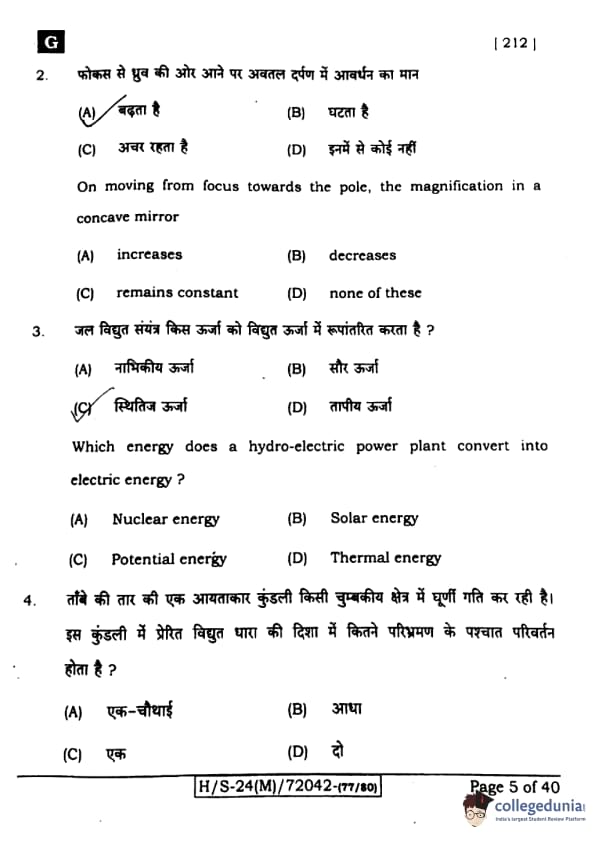
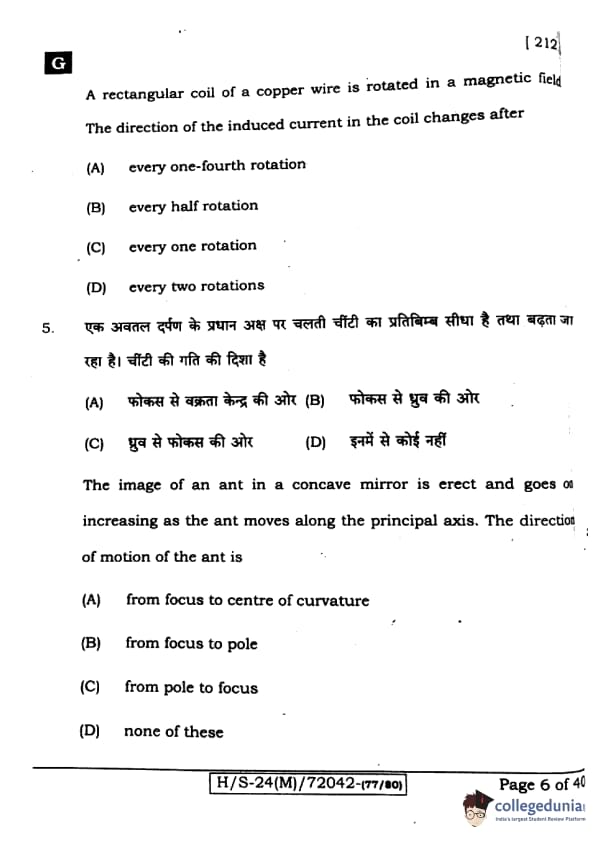
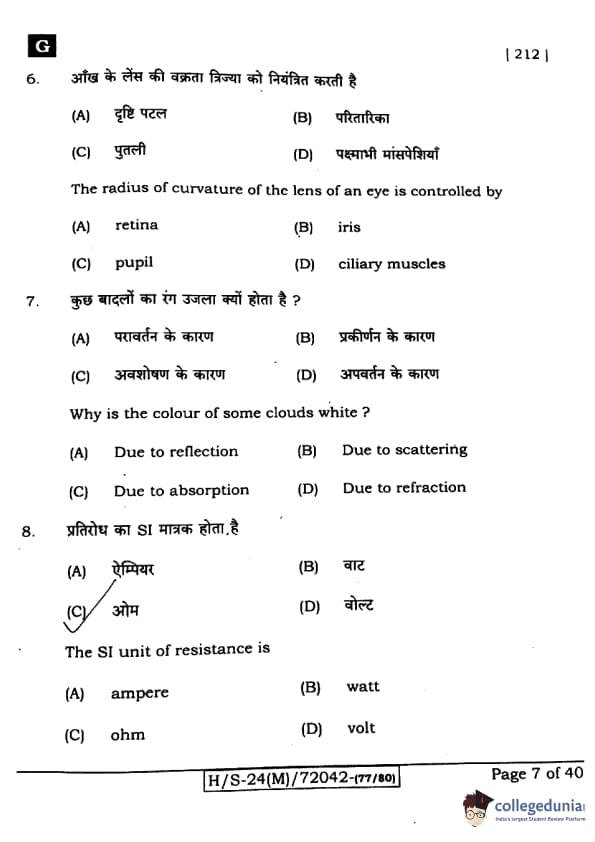

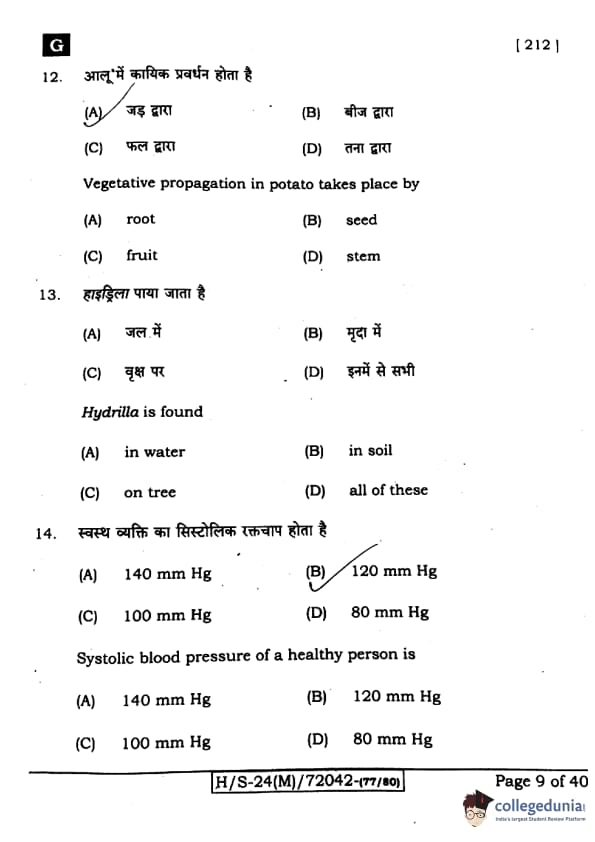
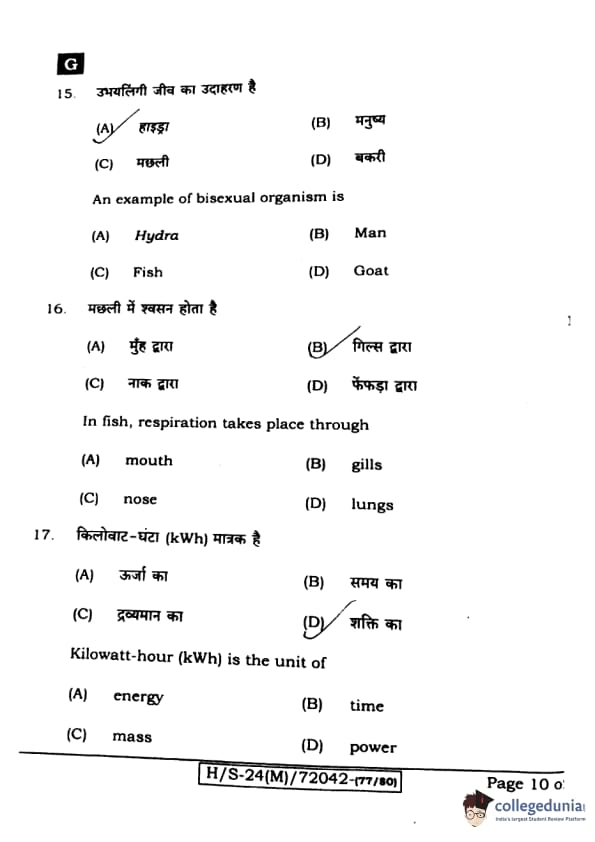
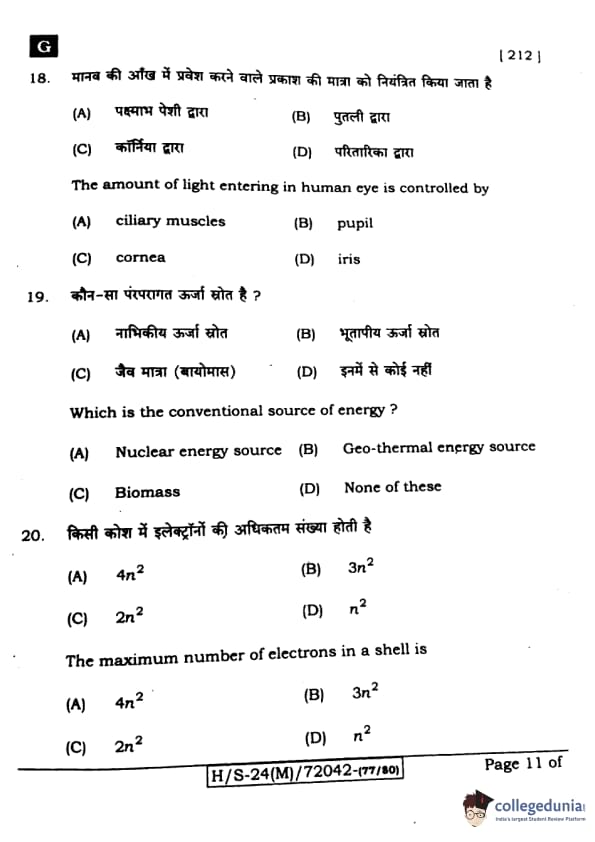


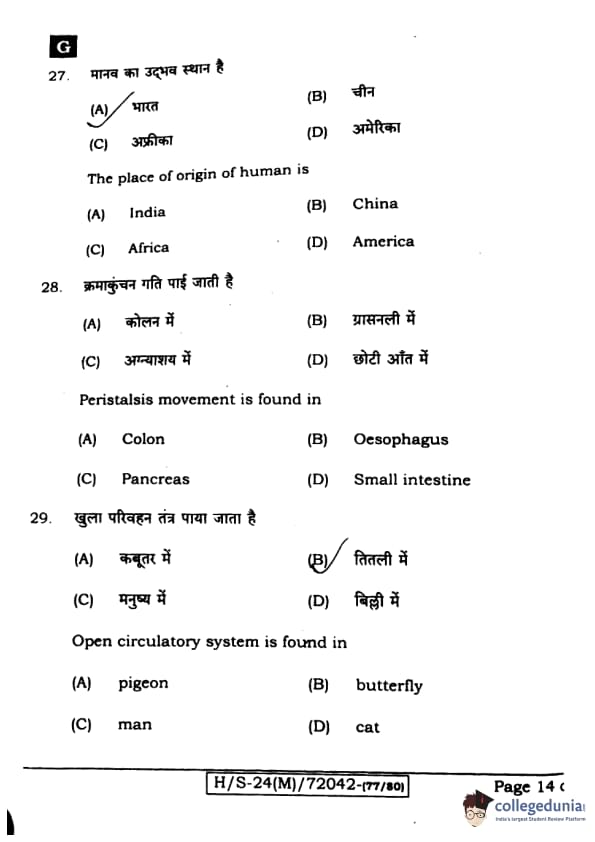

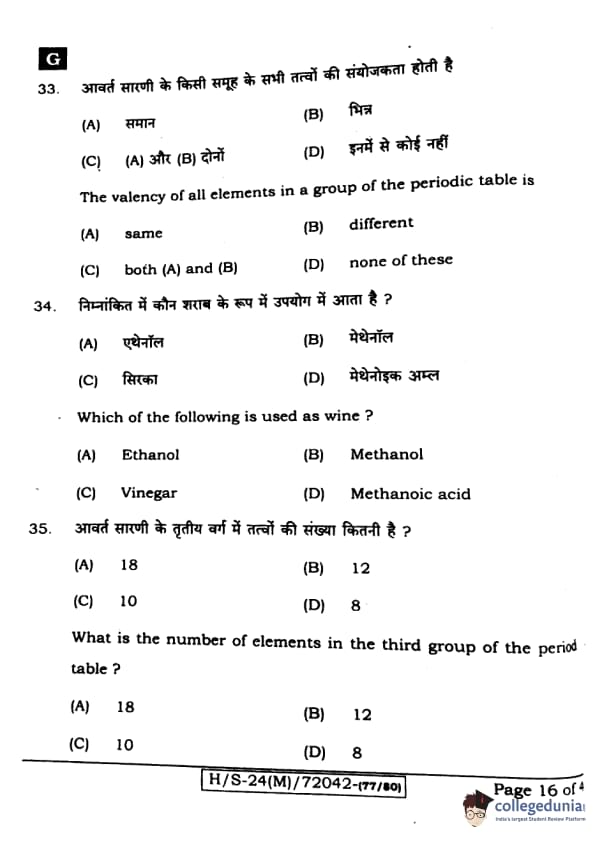
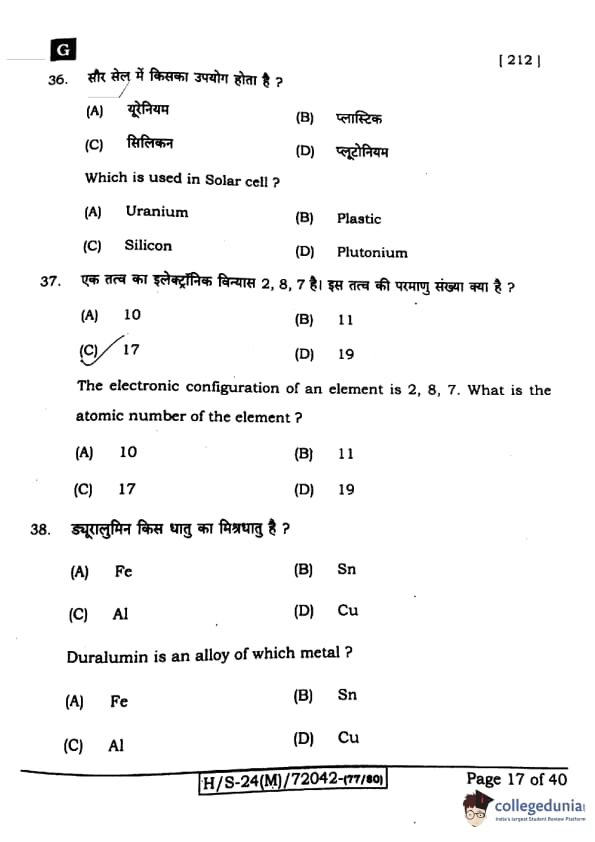


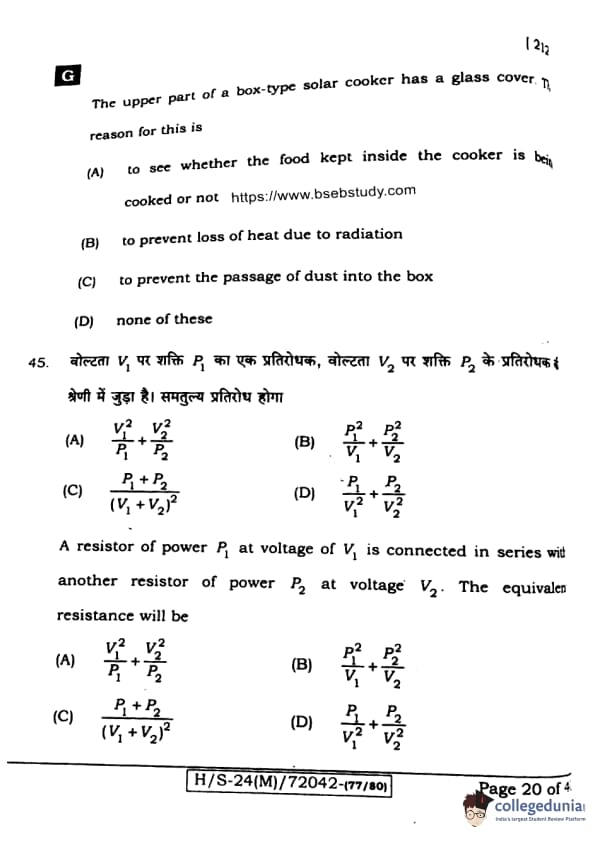

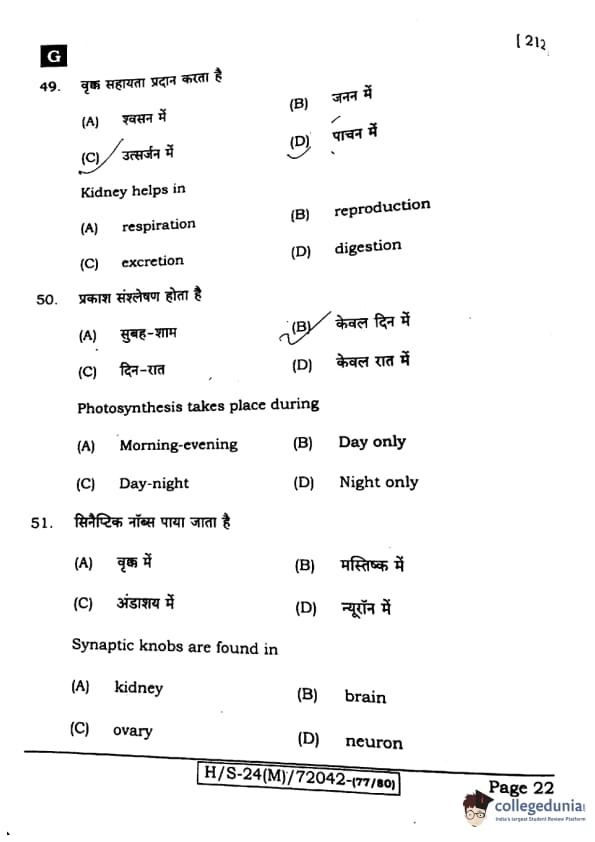
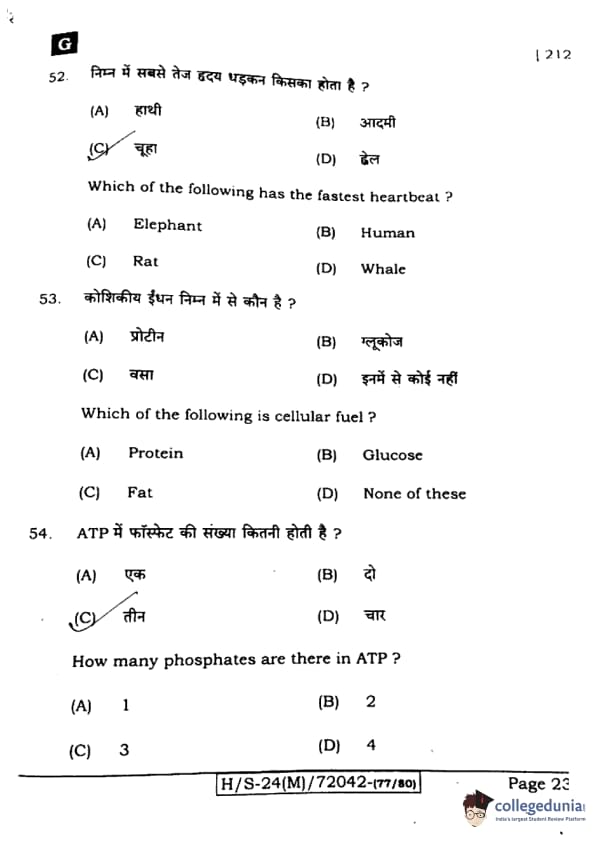





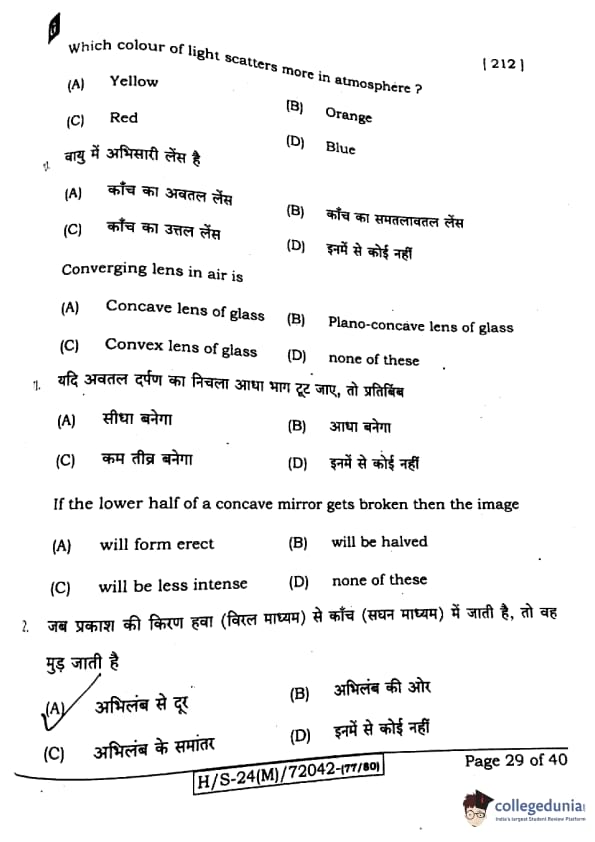
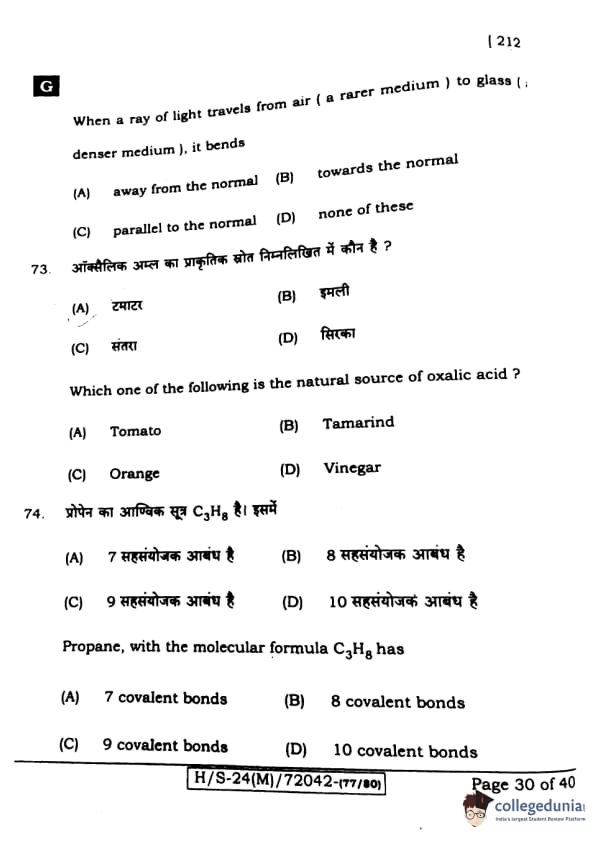




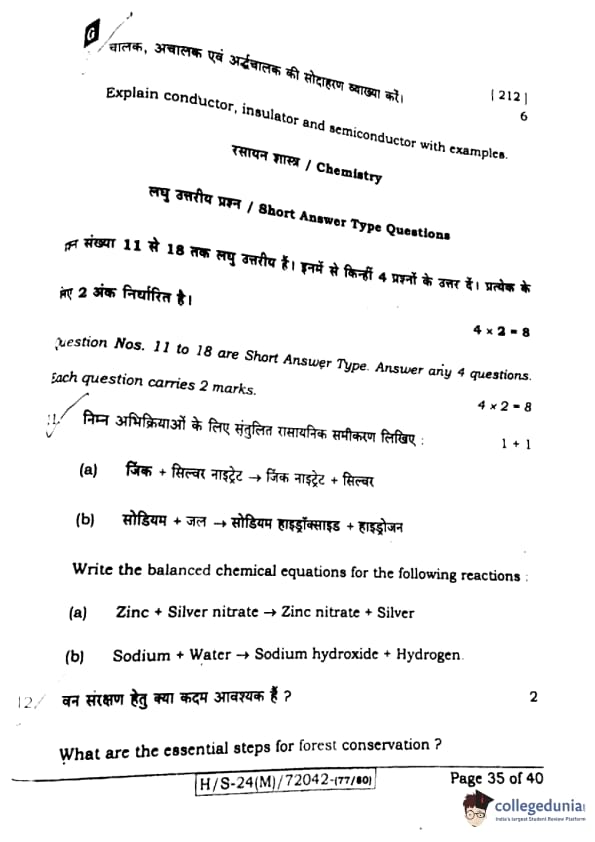







Comments